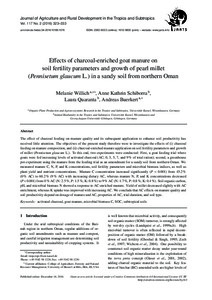Aufsatz

Effects of charcoal-enriched goat manure on soil fertility parameters and growth of pearl millet (Pennisetum glaucum L.) in a sandy soil from northern Oman
Abstract
The effect of charcoal feeding on manure quality and its subsequent application to enhance soil productivity has received little attention. The objectives of the present study therefore were to investigate the effects of (i) charcoal feeding on manure composition, and (ii) charcoal-enriched manure application on soil fertility parameters and growth of millet (Pennisetum glaucum L.). To this end, two experiments were conducted: First, a goat feeding trial where goats were fed increasing levels of activated charcoal (AC; 0, 3, 5, 7, and 9% of total ration); second, a greenhouse pot experiment using the manure from the feeding trial as an amendment for a sandy soil from northern Oman. We measured manure C, N, P, and K concentrations, soil fertility parameters and microbial biomass indices, as well as plant yield and nutrient concentrations. Manure C concentration increased significantly (P<0.001) from 45.2% (0% AC) to 60.2% (9% AC) with increasing dietary AC, whereas manure N, P, and K concentrations decreased (P<0.001) from 0% AC (N: 2.5%, P: 1.5%, K: 0.8%) to 9% AC (N: 1.7%, P: 0.8%, K: 0.4%). Soil organic carbon, pH, and microbial biomass N showed a response to AC-enriched manure. Yield of millet decreased slightly with AC enrichment, whereas K uptake was improved with increasing AC. We conclude that AC effects on manure quality and soil productivity depend on dosage of manure and AC, properties of AC, trial duration, and soil type.
Citation
In: Journal of Agriculture and Rural Development in the Tropics and Subtropics. Kassel : Kassel University Press. - Vol. 117, No. 2 (2016), S. 323-333Collections
Vol 117, No 2 (2016) (Journal of Agriculture and Rural Development in the Tropics and Subtropics (JARTS))Citation
@article{urn:nbn:de:hebis:34-2016101851076,
author={Willich, Melanie and Schiborra, Anne Kathrin and Quaranta, Laura and Buerkert, Andreas},
title={Effects of charcoal-enriched goat manure on soil fertility parameters and growth of pearl millet (Pennisetum glaucum L.) in a sandy soil from northern Oman},
year={2016}
}
0500 Oax 0501 Text $btxt$2rdacontent 0502 Computermedien $bc$2rdacarrier 1100 2016$n2016 1500 1/eng 2050 ##0##urn:nbn:de:hebis:34-2016101851076 3000 Willich, Melanie 3010 Schiborra, Anne Kathrin 3010 Quaranta, Laura 3010 Buerkert, Andreas 4000 Effects of charcoal-enriched goat manure on soil fertility parameters and growth of pearl millet (Pennisetum glaucum L.) in a sandy soil from northern Oman / Willich, Melanie 4030 4060 Online-Ressource 4085 ##0##=u http://nbn-resolving.de/urn:nbn:de:hebis:34-2016101851076=x R 4204 \$dAufsatz 4170 7136 ##0##urn:nbn:de:hebis:34-2016101851076
<resource xsi:schemaLocation="http://datacite.org/schema/kernel-2.2 http://schema.datacite.org/meta/kernel-2.2/metadata.xsd"> 2016-12-15T08:04:02Z 2016-12-15T08:04:02Z 2016-12-14 1612-9830 2363-6033 urn:nbn:de:hebis:34-2016101851076 http://hdl.handle.net/123456789/2016101851076 eng Kassel University Press Urheberrechtlich geschützt https://rightsstatements.org/page/InC/1.0/ activated charcoal goat manure microbial biomass C SOC subtropical soils 630 Effects of charcoal-enriched goat manure on soil fertility parameters and growth of pearl millet (Pennisetum glaucum L.) in a sandy soil from northern Oman Aufsatz The effect of charcoal feeding on manure quality and its subsequent application to enhance soil productivity has received little attention. The objectives of the present study therefore were to investigate the effects of (i) charcoal feeding on manure composition, and (ii) charcoal-enriched manure application on soil fertility parameters and growth of millet (Pennisetum glaucum L.). To this end, two experiments were conducted: First, a goat feeding trial where goats were fed increasing levels of activated charcoal (AC; 0, 3, 5, 7, and 9% of total ration); second, a greenhouse pot experiment using the manure from the feeding trial as an amendment for a sandy soil from northern Oman. We measured manure C, N, P, and K concentrations, soil fertility parameters and microbial biomass indices, as well as plant yield and nutrient concentrations. Manure C concentration increased significantly (P<0.001) from 45.2% (0% AC) to 60.2% (9% AC) with increasing dietary AC, whereas manure N, P, and K concentrations decreased (P<0.001) from 0% AC (N: 2.5%, P: 1.5%, K: 0.8%) to 9% AC (N: 1.7%, P: 0.8%, K: 0.4%). Soil organic carbon, pH, and microbial biomass N showed a response to AC-enriched manure. Yield of millet decreased slightly with AC enrichment, whereas K uptake was improved with increasing AC. We conclude that AC effects on manure quality and soil productivity depend on dosage of manure and AC, properties of AC, trial duration, and soil type. open access In: Journal of Agriculture and Rural Development in the Tropics and Subtropics. Kassel : Kassel University Press. - Vol. 117, No. 2 (2016), S. 323-333 Willich, Melanie Schiborra, Anne Kathrin Quaranta, Laura Buerkert, Andreas Gedruckte Ausg. im Verlag Kassel Univ. Press (www.upress.uni-kassel.de) erschienen. </resource>
The following license files are associated with this item:
Urheberrechtlich geschützt

